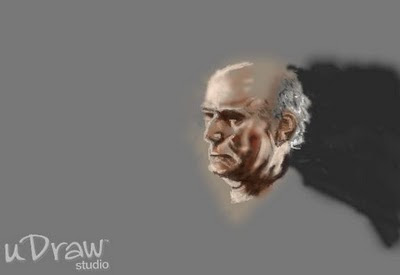When last we met I was showing off my uDraw pieces for worldofudraw.com (more to come BTW, just not for the same reason), and saying I'd reveal my favourite feature of the software while giving a more in depth look at the creation of the portrait. Well, I'm not - at least not the way I intended because it was booooring. No, I came to a realisation while capturing images for this post, so it's going to be cut down, but hopefully more interesting.
We'll get to the realisation in a moment, but first of all a little background, and that neat feature.
uDraw has a memory limit, as I mentioned last time, that prevents you from painting too much. This seems really odd and silly (and it still does, but we'll get there) but it's for a reason. Every stroke you make in uDraw is recorded. Every last one. Each time you make a brush stroke it stores it in memory. The more stokes you make, the more memory is used, and there's only so much to go around.
The upshot of this is that it has a replay mode. In fact you have to sit through the replay every time you open a previously saved image for editing. This isn't too bad until you've painted rather a lot, at which point it seems to take a while. Anyway, this replay effectively gives you an undo feature that can undo all the way back to a blank canvas, and also allows you to see the way you painted something. When I'm painting or drawing I don't really think to hard about how I'm doing it, so this is actually pretty fascinating, and useful (I can see where things went horribly wrong too). It also allows me to go back and grab scenes of an in progress painting without having to save multiple versions as I go along - making this post possible. Neat right?
Okay, okay, stop nagging, here's an image to tide you over.
So that was after a couple of minutes painting (a blink of an eye at the replay's top speed). Dammit, why does Blogger nuke paragraphs of text when I only want to undo one bloody word? Now I have to type loads over again. I'm not doing it, you'll have to deal with just the highlights:
- David Kassan
- Technique
- Nicked
- Looks rubbish
- So far
This put me in mind of something a work
"My issue," He said, well, close enough, "is that I paint or draw and it looks bad, and because it looks bad I lose all interest in carrying on, so I don't, which leaves me with a bunch of unfinished bad things that don't inspire me to do more." (OK, it was nothing like that, but that was the gist of what he said)
This was in reference to something unrelated to this post (but very related to one coming up), and this 30 seconds to glory event on the timeline reminded me of it. There is a point in probably the majority of art work, where it goes from looking like junk to looking amazing (or at least acceptable). Up to that point working on a piece can be pretty depressing, especially if that switch is a long time coming. Here's where it occured on this piece - remember, 30 seconds to a minute between these two images:
Nay
Yay!
From that point on it's all gravy.
It reminds me of those wonderful illustrators I used to love on TV, the late great Tony Hart and not so late but equally great Rolf Harris - the same thing would occur. You'd be watching them put seemingly random scribbles down on the paper and suddenly it's an elephant, or Daffy Duck. Harris' catchphrase was even "Can y'tell what it is yet?" Usually you couldn't until the picture was almost done, then one line would transform the unfathomable to the incredible.
And I realise it's happened in the majority of my work as well, much of it posted on this blog. I'm working on an image of The Doctor thinking "Oh no, this is terrible" and all it takes is a highlight on the eye and then it's not too shabby. One white dot makes all the difference.
This does raise the question of when to give something up as a bad job and when to keep plowing on in the hope that the magic will happen. To that I have no answer because I don't know myself.
Practice and experience probably help - I mean I can't see Rolf Harris spending 10 minutes of screen time painting something when he's thinking "Oh no, this is going to be shit?" the whole time - he must just have had the confidence what at some point in the time alloted he was going to make the magic line and turn it all around. Maybe he practiced the night before or something so he could even know when it was going to happen, allowing him to say "Can y'tell what it is yet?" just seconds before you actually could. I don't know. I met him once but was too small and nervous to think of asking such things.
OK, that was the musing, the interesting observance, you can go home now... Oh, OK, I'll show the rest of the in progress images. Incidentally, I don't know if anyone has done research on this topic, but if they haven't I hearby dub it with the dual titles of the "30 Seconds to glory effect" and "The magic line." Here's the images:
fin.









No comments:
Post a Comment